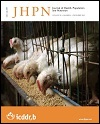Iodized Salt Consumption in Sudan: Present Status and Future Directions
DOI:
https://doi.org/10.3329/jhpn.v30i4.13326Keywords:
Iodine deficiency disorders, Salt legislations, Universal Salt Iodization, SudanAbstract
Iodine Deficiency Disorders (IDD) Control Programme in Sudan adopted salt iodization as the long-term strategy in 1994. In 2000, it was found that less than 1% of households were using adequately-iodized salt. The objectives of this study were to: (i) study the coverage and variation of different geographical regions of Sudan regarding access to and use of iodized salt, (ii) explore the possible factors which influence the use of iodized salt, (iii) develop recommendations to help in the implementation of the Universal Salt Iodization (USI) strategy in Sudan. This paper is based on the Sudan Household Health Survey (SHHS) dataset. A total sample of 24,507 households was surveyed, and 18,786 cooking salt samples were tested for iodine levels with rapid salt-testing kits. Nationally, the percentage of households using adequately-iodized salt increased from less than 1% in 2000 to 14.4%, with wide variations between states. Access to iodized salt ranged from 96.9% in Central Equatoria to 0.4% in Gezira state. Population coverage with iodized salt in Sudan remains very low. The awareness and political support for USI programme is very weak. National legislation banning the sale of non-iodized salt does not exist. Utilization of the already-existing laws, like the National Standardization and Metrology Law (2008), to develop a compulsory national salt specification, will accelerate the USI in Sudan.
DOI: http://dx.doi.org/10.3329/jhpn.v30i4.13326
J HEALTH POPUL NUTR 2012 Dec;30(4):431-438
Downloads
170
215

